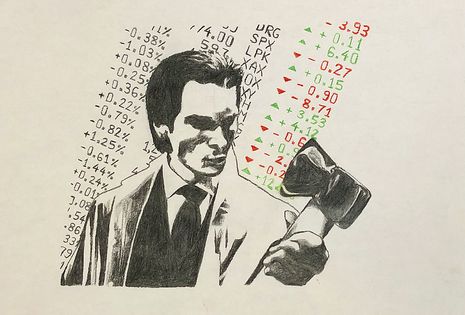The Wall Street Immoralism of American Psycho
Sophie Long examines the transgessive 1991 novel American Psycho and its relation to the immoralism of Wall Street

New York’s Wall Street is undoubtedly the epicentre of the financial world, bringing with it the figureheads of immoral, money-hungry narcissism: stockbrokers. The social stigmatisation of stockbrokers is timeless, and occurs from Wall Street’s very beginnings in the late eighteenth century as an exclusionary collection open only to the professional, male financier inhabiting Manhattan’s Southside. However, as popular culture began to use Wall Street as a backdrop for social commentary, figures like Jordan Belfort (The Wolf of Wall Street) and John Self (Money: A Suicide Note) exemplified the hedonistic lifestyle of the glamorous financial district.
“Can psychopaths walk among us, amassing wealth while topping the food chain of capitalism?”
The Buttonwood Agreement of 1792 placed the New York Stock Exchange on Wall Street, acting as the home of domestic trade for the city’s current markets. Initially consisting of twenty four of New York’s finest brokers, it was the first instance of an organised group controlling the input and output of stocks and trade. At this time, the active trade occurring on Wall Street was that of the American slave trade, which provided the city with tax and assisted in growing the financial district into a coherent marketplace. It seems fitting that Wall Street has its roots in profiteering from dehumanisation, as this image conveniently continues until it reaches its height in Bret Easton Ellis’ American Psycho, where violence and degradation becomes synonymous with the success of the stockbroker. However, it must be determined if Ellis’ fictional stockbroker can be a reflection of the setting of real brokerage in Lower Manhattan’s trading systems. Can psychopaths walk among us, amassing wealth while topping the food chain of capitalism?
The titular ‘American psycho’ in this case is Patrick Bateman, one of the most heinous literary antagonists of the last century. Hidden behind his suave, Wall Street persona is a demented, solipsistic serial-killer that seeks pleasure in the destruction of those inferior to him — the man in the tailored Armani suit. The common thread between Wall Street’s financial beginnings and its evolution into a literary symbol is its associations with moral decline and degradation. Just as the Buttonwood traders profited from the slave trade, Bateman earns his wealth alongside committing violence against women, the unhomed and members of the LGBT+ community. It becomes increasingly obvious — if we use Wall Street as the focus — that where there is significant wealth, there must also be poverty and immoralism. Bateman, in one chapter, can glorify his work — his carefully sculpted exercise routine or his diet — while also detailing incidents of torture, humiliation and murder. For Bateman to exist in the high-class of American stock trading and finance, there must be the inverse to fulfil his pleasures: the victims of the lower classes that threaten the integrity and validity of Bateman’s world.
Although, it isn’t necessary that Bateman must kill in order to maintain his position on a social pedestal; it is rather his familiarity with violence that comes as a package deal, a freebie with the purchase of his sleek business cards or matching Hugo Boss cufflinks. Wall Street, in all its glamour, is a catalyst for Bateman’s lapse into psychosis. When insignificant moments of inferiority among his Wall Street colleagues damage his self-confidence, he must respond with inflamed episodes of violence. Therefore, is it fair to conclude that Bateman is a product of his surroundings, or must we accept the inherent nature of a contemptible — yet imaginary — antagonist? Ellis is undoubtedly satirising the culture of Wall Street as he saw it in the late nineties and formed his novel upon the basis that readers will identify the sardonic villainy of Bateman and reflect on the current happenings of Wall Street.
Psychotic sybarites, like Bateman, are unlikely to flock to Wall Street in actuality, but Ellis proposes the important question that they might. Machiavellians populate high society and in return earn fortune and fame, hence why Ellis decides that Bateman can be exposed as he is at the height of evil hidden in the fiscal world — a world in which Bateman fits and remains undetected throughout the novel. The reader is asked to decide whether Bateman actually did kill his victims, or if it is a form of escapism from the vacuum of Wall Street monotony. Is the demonic fantasyland of Wall Street just an imagined world of Ellis’ creation? A psychopathic playground that exists only as a mental fabrication in the mind of Bateman? Or, does the real life Wall Street breed a violence that began with the profits of the American slave trade in New York City?
 News / Cambridge bus strikes continue into new year16 January 2026
News / Cambridge bus strikes continue into new year16 January 2026 News / Local business in trademark battle with Uni over use of ‘Cambridge’17 January 2026
News / Local business in trademark battle with Uni over use of ‘Cambridge’17 January 2026 Interviews / The Cambridge Cupid: what’s the secret to a great date?14 January 2026
Interviews / The Cambridge Cupid: what’s the secret to a great date?14 January 2026 News / Uni members slam ‘totalitarian’ recommendation to stop vet course 15 January 2026
News / Uni members slam ‘totalitarian’ recommendation to stop vet course 15 January 2026 Science / Why smart students keep failing to quit smoking15 January 2026
Science / Why smart students keep failing to quit smoking15 January 2026










